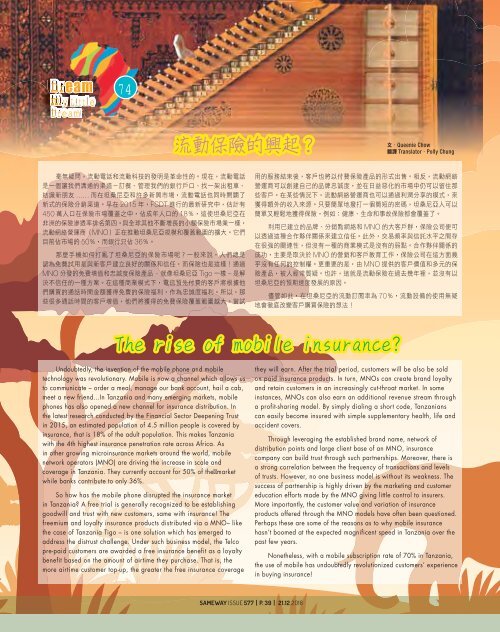Create successful ePaper yourself
Turn your PDF publications into a flip-book with our unique Google optimized e-Paper software.
Dream<br />
my Little<br />
Dream<br />
74<br />
<br />
Queenie Chow<br />
TranslatorPolly Chung<br />
<br />
<br />
...... <br />
2015 FSDT <br />
450 18<br />
<br />
MNO<br />
50 36<br />
<br />
<br />
MNO - Tigo – <br />
<br />
<br />
<br />
<br />
<br />
<br />
<br />
<br />
MNO <br />
<br />
<br />
MNO <br />
MNO <br />
<br />
<br />
70<br />
<br />
<br />
Undoubtedly, the invention of the mobile phone and mobile<br />
technology was revolutionary. Mobile is now a channel which allows us<br />
to communicate – order a meal, manage our bank account, hail a cab,<br />
meet a new friend…In Tanzania and many emerging markets, mobile<br />
phones has also opened a new channel for insurance distribution. In<br />
the latest research conducted by the Financial Sector Deepening Trust<br />
in 2015, an estimated population of 4.5 million people is covered by<br />
insurance, that is 18% of the adult population. This makes Tanzania<br />
with the 4th highest insurance penetration rate across Africa. As<br />
in other growing microinsurance markets around the world, mobile<br />
network operators (MNO) are driving the increase in scale and<br />
coverage in Tanzania. They currently account for 50% of themarket<br />
while banks contribute to only 36%.<br />
So how has the mobile phone disrupted the insurance market<br />
in Tanzania? A free trial is generally recognized to be establishing<br />
goodwill and trust with new customers, same with insurance! The<br />
freemium and loyalty insurance products distributed via a MNO– like<br />
the case of Tanzania Tigo – is one solution which has emerged to<br />
address the distrust challenge. Under such business model, the Telco<br />
pre-paid customers are awarded a free insurance benefit as a loyalty<br />
benefit based on the amount of airtime they purchase. That is, the<br />
more airtime customer top-up, the greater the free insurance coverage<br />
they will earn. After the trial period, customers will be also be sold<br />
on paid insurance products. In turn, MNOs can create brand loyalty<br />
and retain customers in an increasingly cut-throat market. In some<br />
instances, MNOs can also earn an additional revenue stream through<br />
a profit-sharing model. By simply dialing a short code, Tanzanians<br />
can easily become insured with simple supplementary health, life and<br />
accident covers.<br />
Through leveraging the established brand name, network of<br />
distribution points and large client base of an MNO, insurance<br />
company can build trust through such partnerships. Moreover, there is<br />
a strong correlation between the frequency of transactions and levels<br />
of trusts. However, no one business model is without its weakness. The<br />
success of partnership is highly driven by the marketing and customer<br />
education efforts made by the MNO giving little control to insurers.<br />
More importantly, the customer value and variation of insurance<br />
products offered through the MNO models have often been questioned.<br />
Perhaps these are some of the reasons as to why mobile insurance<br />
hasn’t boomed at the expected magnificent speed in Tanzania over the<br />
past few years.<br />
Nonetheless, with a mobile subscription rate of 70% in Tanzania,<br />
the use of mobile has undoubtedly revolutionized customers’ experience<br />
in buying insurance!<br />
SAMEWAY ISSUE 577 P. 39 21.12.2018













